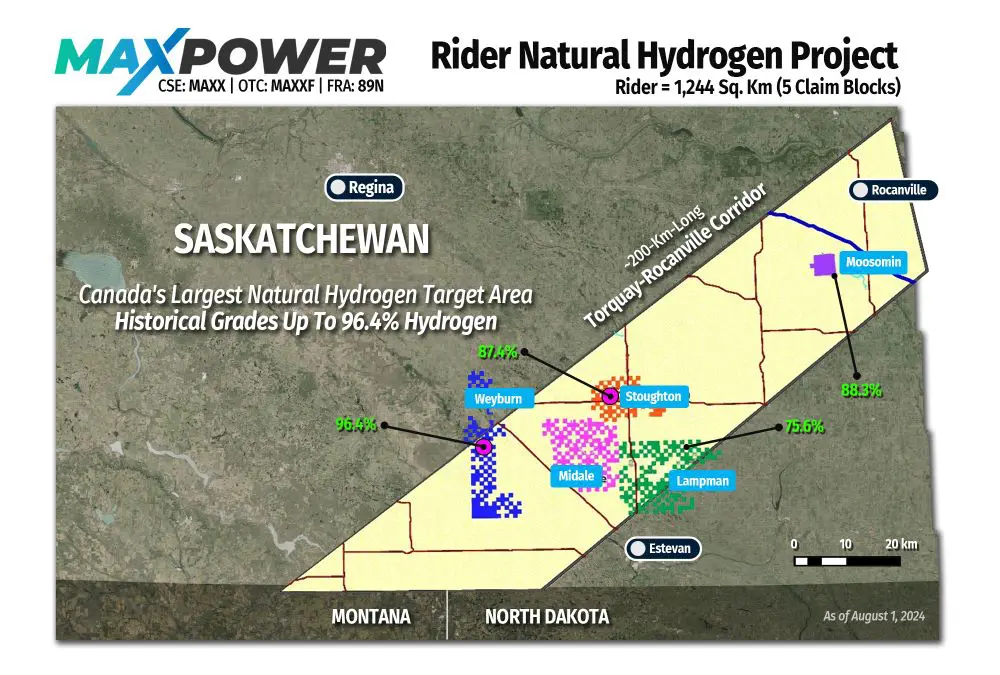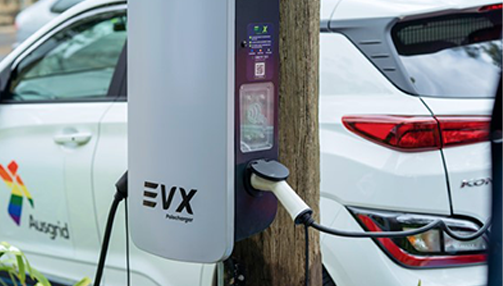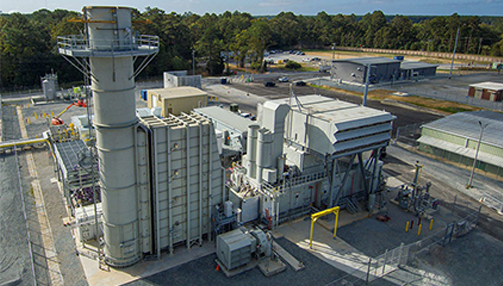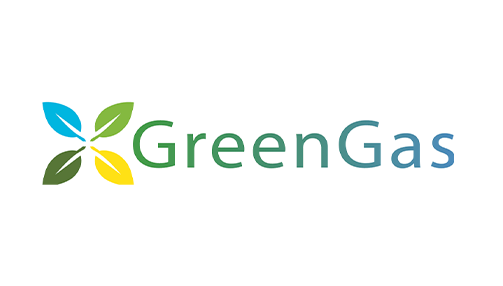
New Naturally Occurring Hydrogen Discovery In Saskatchewan

Mineral exploration company MAX Power Mining Corp. (MAX Power) believes that hydrogen that can be found naturally in accumulations in the earth’s subsurface is a game changer for the hydrogen industry and could become a source for the lowest cost and purest hydrogen available. The vast majority of the world’s hydrogen is produced from fossil fuels. And even hydrogen that is made from renewable means, such as electrolysis, is still resource intensive because it requires vast amounts of water.
Utilizing proprietary methods and data modelling, MAX Power has identified a prospective naturally occurring hydrogen resource play in southeast Saskatchewan, Canada featuring dozens of historical hydrogen showings, including grades up to 96.4%. As a result, through a series of permit applications, MAX Power has assembled a 480 sq. mile (1,244 sq. km) land package, now referred to as the Rider Natural Hydrogen Project, situated within the 124-mike-long (200 km) NE-SW striking Torquay-Rocanville Corridor.
According to MAX Power, multiple high-priority target areas exist across five separate large claim blocks and include evidence of potential upward migration of hydrogen to the surface, possibly through serpentinization or fracture zones, making the Rider Natural Hydrogen Project the largest known area in Canada for the potential discovery of naturally occurring accumulations of hydrogen gas. MAX Power’s staking covers almost all the available Crown land as well as natural hydrogen targets within the Torquay-Rocanville Corridor.
Southern Saskatchewan is entirely covered by the pervasive and thick Western Canadian Sedimentary Basin (WCSB), which directly overlies the crystalline Pre-Cambrian basement. The basement is the perceived source for naturally occurring hydrogen, especially where the basement rock has an ultramafic composition. There are a series of deep structures, including faults, allowing movement of gasses from the basement upwards into the WCSB. In addition to structures, a series of domes and arches add to the structural complexity of the WCSB. Natural Hydrogen migrates upward into certain geological formations where it can accumulate.
Project Highlights
- Two blocks at the Rider Natural Hydrogen Project include very high concentrations of hydrogen (4% at Weyburn and 87.4% at Stoughton) from the wellhead, supported by historical drill stem tests from old wells, indicating that natural hydrogen may have migrated to the surface.
- Two additional high-grade showings (3% and 75.6%) from the wellhead also occur within 2625 ft (800 m) and 656 ft (200 m), respectively, of MAX Power land claims.
- Given the limited number of wells (45) in the data set covering the Rider Natural Hydrogen Project, vs. the number of total wells believed to have been drilled in the region for which data is not available, the fact that seven of these wells showed hydrogen grades >10% at varying depths takes on added significance (the other 38 showed hydrogen grades between 1% and 10%).
A New Strategic Alliance
In June, MAX Power and Chapman Hydrogen and Petroleum Engineering Ltd. (Chapman) entered a strategic alliance to help the companies identify opportunities for natural hydrogen developments across Canada, and eventually the US. Chapman helped confirm the world’s first discovery of an accumulation of Natural Hydrogen gas in Mali, West Africa, last decade. The discovery, which quickly provided low-cost, emissions-free electricity for an entire village, was supported by the world’s first-ever Hydrogen NI 51-101 report written by Denis Brière, MAX Power Special Advisor and vice president of engineering for Chapman Hydrogen and Petroleum Engineering Ltd.
“My involvement in the world’s first discovery of a naturally occurring hydrogen gas accumulation in Mali, West Africa, over a decade ago was tremendously gratifying, especially since it quickly powered an entire village with low-cost, emissions-free electricity,” said Brière, VP-Engineering for Chapman Hydrogen and Petroleum Engineering Ltd. “This news from Saskatchewan – the scale of the opportunity and the very high historical grades – represents a watershed development for the world in the rapidly emerging Natural Hydrogen sector. Chapman is looking forward to working with MAX Power to take the Rider Natural Hydrogen Project to the next level.”
The Path Forward
Geologists are designing a near-term program to verify and validate the existence of a naturally occurring hydrogen trend at the Rider Natural Hydrogen Project. MAX Power continues to review an extensive array of datasets in Saskatchewan and elsewhere. According to MAX Power, Saskatchewan is positioned to become the first jurisdiction in North America to produce natural hydrogen given a combination of highly favorable geology and a clearly defined policy framework for exploration and development of this important new alternate energy source.
“The acquisition of key permits to form the Rider Natural Hydrogen Project in SE Saskatchewan is a major development for MAX Power as we hit the ground running with the largest target area in the country for Natural Hydrogen in one of the best jurisdictions globally for exploration and resource development,” said MAX Power CEO Rav Mlait. “The efforts of the MAX Power team are to be commended as we have used proprietary methods and state-of-the-art data modelling to uncover best-in-class targets. I recently met with top government officials in Saskatchewan and we are very enthused to be working in this forward-looking province. Natural Hydrogen is the cleanest form of hydrogen and can be developed at the lowest cost relative to other hydrogen (manufactured) variations. MAX Power has the potential to ignite a whole new energy boom in Canada and North America.”









